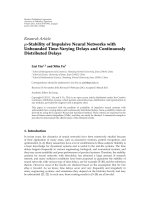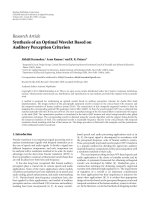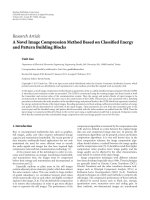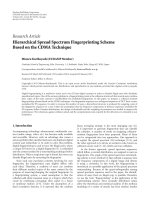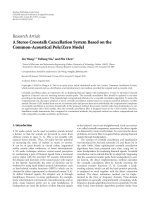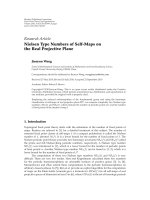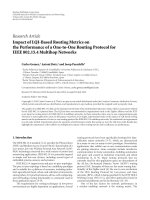Báo cáo hoa học: "Research Article Bounds for Certain New Integral Inequalities on Time Scales" pptx
Bạn đang xem bản rút gọn của tài liệu. Xem và tải ngay bản đầy đủ của tài liệu tại đây (538.71 KB, 16 trang )
Hindawi Publishing Corporation
Advances in Difference Equations
Volume 2009, Article ID 484185, 16 pages
doi:10.1155/2009/484185
Research Article
Bounds for Certain New Integral Inequalities on
Time Scales
Wei Nian Li1, 2
1
2
Department of Applied Mathematics, Shanghai Normal University, Shanghai 200234, China
Department of Mathematics, Binzhou University, Shandong 256603, China
Correspondence should be addressed to Wei Nian Li,
Received 31 March 2009; Accepted 10 June 2009
Recommended by Victoria Otero-Espinar
Our aim in this paper is to investigate some new integral inequalities on time scales, which provide
explicit bounds on unknown functions. Our results unify and extend some integral inequalities
and their corresponding discrete analogues. The inequalities given here can be used as handy
tools to study the properties of certain dynamic equations on time scales.
Copyright q 2009 Wei Nian Li. This is an open access article distributed under the Creative
Commons Attribution License, which permits unrestricted use, distribution, and reproduction in
any medium, provided the original work is properly cited.
1. Introduction
The study of dynamic equations on time scales, which goes back to its founder Hilger 1 ,
is an area of mathematics that has recently received a lot of attention. For example, we
refer the reader to literatures 2–8 and the references cited therein. At the same time, some
fundamental integral inequalities used in analysis on time scales have been extended by
many authors 9–14 . In this paper, we investigate some new nonlinear integral inequalities
on time scales, which unify and extend some continuous inequalities and their corresponding
discrete analogues. Our results can be used as handy tools to study the properties of certain
dynamic equations on time scales.
Throughout this paper, a knowledge and understanding of time scales and time scale
notation is assumed. For an excellent introduction to the calculus on time scales, we refer the
reader to monographes 2, 3 .
2. Main Results
In what follows, R denotes the set of real numbers, R
0, ∞ , Z denotes the set of integers,
{0, 1, 2, . . .} denotes the set of nonnegative integers, C M, S denotes the class of all
N0
continuous functions defined on set M with range in the set S, T is an arbitrary time scale,
2
Advances in Difference Equations
Crd denotes the set of rd-continuous functions, R denotes the set of all regressive and rd{p ∈ R : 1 μ t p t > 0, ∀t ∈ T}. We use the usual conventions
continuous functions, and R
that empty sums and products are taken to be 0 and 1, respectively. Throughout this paper,
we always assume that p ≥ 1, 0 < q ≤ p, p, and q are real constants, and t ≥ t0 , t0 ∈ Tκ .
We firstly introduce the following lemmas, which are useful in our main results.
Lemma 2.1
15
Bernoulli’s inequality . Let 0 < α ≤ 1 and x > −1. Then 1
x
α
≤1
αx.
Lemma 2.2 2 . Let t0 ∈ Tκ and w : T × Tκ → R be continuous at t, t , where t ≥ t0 , t ∈ Tκ with
t > t0 . Assume that wΔ t, · is rd-continuous on t0 , σ t . If for any ε > 0, there exists a neighborhood
U of t, independent of τ ∈ t0 , σ t , such that
w σ t , τ − w s, τ − wΔ t, τ σ t − s
≤ ε|σ t − s|,
∀s ∈ U,
2.1
where wΔ denotes the derivative of w with respect to the first variable, then
t
g t :
w t, τ Δτ
2.2
t0
implies
gΔ t
t
wΔ t, τ Δτ
w σ t ,t .
2.3
t0
Lemma 2.3
2
Comparison Theorem . Suppose u, b ∈ Crd , a ∈ R . Then
uΔ t ≤ a t u t
b t ,
t ≥ t0 , t ∈ Tκ ,
2.4
implies
u t ≤ u t0 ea t, t0
t
ea t, σ τ b τ Δτ,
t ≥ t0 , t ∈ Tκ .
2.5
t0
Lemma 2.4 see 13 . Let u, f, g ∈ Crd , u t , f t , and g t be nonnegative. If f t is
nondecreasing, then
u t ≤f t
t
g τ u τ Δτ,
t ∈ Tκ ,
2.6
t0
implies
u t ≤ f t eg t, t0 ,
t ∈ Tκ ,
2.7
Advances in Difference Equations
3
Next, we establish our main results.
Theorem 2.5. Assume that u, a, b, g, h ∈ Crd , a t > 0, u t , b t , g t and h t are nonnegative.
Then
t
up t ≤ a t
b t
h τ Δτ,
g τ uq τ
t ∈ Tκ ,
2.8
t0
implies
t
1 1/p−1
a
t b t
p
u t ≤ a1/p t
eB t, σ τ F τ Δτ,
t ∈ Tκ ,
2.9
t0
where
F t
g t aq/p t
B t
q q/p−1
a
t b t g t ,
p
h t ,
2.10
t ∈ Tκ .
2.11
Proof. Define a function z t by
t
zt
g τ uq τ
h τ Δτ.
2.12
t0
Then 2.8 can be restated as
up t ≤ a t
b t zt
a t
1
b t zt
a t
.
2.13
Using Lemma 2.1, from the above inequality, we easily obtain
u t ≤ a1/p t
1 1/p−1
a
t b tzt ,
p
2.14
uq t ≤ aq/p t
q q/p−1
a
t b tzt .
p
2.15
It follows from 2.12 and 2.15 that
zΔ t
g t uq t
≤g t
F t
h t
aq/p t
B t zt,
q q/p−1
a
t b t zt
p
t ∈ Tκ ,
h t
2.16
4
Advances in Difference Equations
where F t and B t are defined as in 2.10 and 2.11 , respectively. Using Lemma 2.3 and
0, from 2.16 we have
noting z t0
z t ≤
t
eB t, σ τ F τ Δτ,
t ∈ Tκ .
2.17
t0
Therefore, the desired inequality 2.9 follows from 2.14 and 2.17 . This completes
the proof of Theorem 2.5.
Corollary 2.6. Assume that u, g ∈ Crd , u t , and g t are nonnegative. If α > 0 is a constant, then
t
up t ≤ α
g τ uq τ Δτ,
t ∈ Tκ ,
2.18
t0
implies
u t ≤ α1/p 1 −
1
e t, t0
q B
1
q
,
t ∈ Tκ ,
2.19
where
q q/p−1
α
g t ,
p
B t
Proof. Letting a t
α, b t
F t
1, and h t
αq/p g t ,
t ∈ Tκ .
2.20
0 in Theorem 2.5, we obtain
B t
q q/p−1
α
g t : B t,
p
t ∈ Tκ .
Therefore,
u t ≤ α1/p
α1/p
1 1/p−1
α
p
t
1 1/p−1
α
p
t
t0
t0
eB t, σ τ F τ Δτ
eB t, σ τ αq/p g τ Δτ
2.21
Advances in Difference Equations
α1/p
α1/p
5
1 1/p
α
q
t
1 1/p
α
q
t
t0
t0
q q/p−1
α
g τ Δτ
p
eB t, σ τ
eB t, σ τ B τ Δτ
α1/p
1 1/p
α
eB t, t0 − eB t, t
q
α1/p
1 1/p
1
α eB t, t0 − α1/p
q
q
α1/p 1 −
1
e t, t0
q B
1
q
t ∈ Tκ .
,
2.22
The proof of Corollary 2.6 is complete.
Remark 2.7. The result of Theorem 2.5 holds for an arbitrary time scale. Therefore, using
Theorem 2.5, we can obtain many results for some peculiar time scales. For example, letting
T R and T Z, respectively, we have the following two results.
Corollary 2.8. Let T
Then the inequality
R and assume that u t , a t , b t , g t , h t ∈ C R , R , and a t > 0.
t
up t ≤ a t
b t
g s uq s
h s ds,
t∈R ,
2.23
0
implies
u t ≤ a1/p t
1 1/p−1
a
t b t
p
t
t
F θ exp
B s ds dθ,
0
t∈R ,
2.24
θ
where F t and B t are defined as in Theorem 2.5.
Corollary 2.9. Let T
Z and assume that a t > 0, u t , b t , g t , and h t are nonnegative
functions defined for t ∈ N0 . Then the inequality
up t ≤ a t
t−1
b t
g s uq s
h s ,
t ∈ N0 ,
2.25
s 0
implies
u t ≤ a1/p t
1 1/p−1
a
t b t
p
t−1
t−1
F θ
θ 0
where F t and B t are defined as in Theorem 2.5.
1
s θ 1
B s ,
t ∈ N0 ,
2.26
6
Advances in Difference Equations
Investigating the proof procedure of Theorem 2.5 carefully, we easily obtain the
following more general result.
Theorem 2.10. Assume that u, a, b, gi , hi ∈ Crd , a t > 0, u t , b t , gi t , and hi t are
nonnegative, i 1, 2, . . . , n. If there exists a series of positive real numbers q1 , q2 , . . . , qn such that
p ≥ qi > 0, i 1, 2, . . . , n, then
n
t
i 1
up t ≤ a t
t0
b t
gi τ uqi τ
hi τ Δτ,
t ∈ Tκ ,
2.27
implies
t
1 1/p−1
a
t b t
p
u t ≤ a1/p t
eB∗ t, σ τ F ∗ τ Δτ,
t ∈ Tκ ,
2.28
t0
where
F∗ t
n
gi t aqi /p t
B∗ t
hi t ,
n
b t
i 1
i
qi qi /p−1
a
t gi t .
p
1
2.29
Theorem 2.11. Assume that u, a, b, f, g, m ∈ Crd , a t > 0, u t , b t , f t , g t and m t are
nonnegative. If w t, s is defined as in Lemma 2.2 such that w t, s ≥ 0 and wΔ t, s ≥ 0 for t, s ∈ T
with s ≤ t, then
up t ≤ a t
t
b t
w t, τ f τ up τ
m τ Δτ,
g τ uq τ
t ∈ Tκ ,
2.30
t0
implies
t
1 1/p−1
a
t b t
p
u t ≤ a1/p t
eA t, σ τ G τ Δτ,
t ∈ Tκ ,
2.31
t0
where
A t
w σ t ,t b t
t
w
Δ
f t
t, τ b τ
q q/p−1
a
tg t
p
f τ
t0
G t
w σ t ,t a t f t
t
t0
q q/p−1
a
τ g τ
p
g t aq/p t
wΔ t, τ a τ f τ
2.32
Δτ,
m t
2.33
g τ aq/p τ
m τ Δτ.
Advances in Difference Equations
7
Proof. Define a function z t by
t
zt
w t, τ f τ up τ
m τ Δτ,
g τ uq τ
t ∈ Tκ .
2.34
t0
0. As in the proof of Theorem 2.5, we easily obtain 2.14 and 2.15 . Using
Then z t0
Lemma 2.2 and combining 2.34 and 2.15 , we have
zΔ t
w σ t , t f t up t
t
g t uq t
wΔ t, τ f τ up τ
m t
m τ Δτ
g τ uq τ
t0
≤ w σ t ,t a t f t
t
g t aq/p t
wΔ t, τ a τ f τ
m t
g τ aq/p τ
b t
q q/p−1
a
t g t
p
f t
zt
mτ
t0
b τ
≤ w σ t ,t b t
t
q q/p−1
a
t g τ
p
f τ
t0
w σ t ,t a t f t
t
zτ
Δτ
2.35
q q/p−1
a
t g t
p
f t
wΔ t, τ b τ
q q/p−1
a
tg τ
p
f τ
g t aq/p t
wΔ t, τ a τ f τ
Δτ z t
mt
g τ aq/p τ
m τ Δτ
t0
At zt
Gt ,
t ∈ Tκ ,
where A t and G t are defined as in 2.32 and 2.33 , respectively. Therefore, in the above
inequality, using Lemma 2.3 and noting z t0
0, we get
zt ≤
t
eA t, σ τ G τ Δτ,
t ∈ Tκ .
2.36
t0
It is easy to see that the desired inequality 2.31 follows from 2.14 and 2.36 . This
completes the proof of Theorem 2.11.
8
Advances in Difference Equations
Corollary 2.12. Let T R and assume that u t , a t , b t , f t , g t , m t ∈ C R , R , a t > 0.
If w t, s and its partial derivative ∂w t, s /∂t are real–valued nonnegative continuous functions for
t, s ∈ R with s ≤ t, then the inequality
up t ≤ a t
t
b t
w t, s f s up s
g s uq s
t∈R ,
m s ds,
2.37
0
implies
t
1 1/p−1
a
t b t
p
u t ≤ a1/p t
t
G s exp
0
t∈R ,
A τ dτ ds,
2.38
s
where
At
w t, t b t
q q/p−1
a
t g t
p
f t
t
∂w t, s
b s
∂t
0
Gt
w t, t a t f t
q q/p−1
a
s g s
p
f s
q/p
g t a
t
∂w t, s
a s f s
∂t
0
t
ds,
2.39
m t
g s aq/p s
m s ds.
Corollary 2.13. Let T Z and assume that a t > 0, u t , b t , f t , g t and m t are nonnegative
functions defined for t ∈ N0 . If w t, s and Δ1 w t, s are real-valued nonnegative functions for t, s ∈
N0 with s ≤ t, then the inequality
up t ≤ a t
t−1
b t
w t, s f s up s
g s uq s
m s ,
t ∈ N0 ,
2.40
s 0
implies
u t ≤ a1/p t
1 1/p−1
a
t b t
p
t−1
t−1
1
G s
s 0
τ s 1
A τ
,
t ∈ N0 ,
2.41
Advances in Difference Equations
where Δ1 w t, s
9
1, s − w t, s for t, s ∈ N0 with s ≤ t,
w t
A t
w t
t−1
1, t b t
q q/p−1
a
t g t
p
f t
Δ1 w t, s b s
q q/p−1
a
sg s
p
f s
s 0
G t
w t
t−1
q/p
1, t a t f t
g t a
Δ1 w t, s a s f s
t
,
2.42
m t
g s aq/p s
m s .
s 0
Corollary 2.14. Suppose that u t , a t , and w t, s are defined as in Theorem 2.11. If a t is
nondecreasing for t ∈ Tκ , then
up t ≤ a t
t
w t, τ uq τ Δτ,
t ∈ Tκ ,
2.43
1
e t, t0 ,
q A
t ∈ Tκ ,
2.44
t0
implies
u t ≤ a1/p t 1 −
1
q
where
q
p
A t
Proof. Letting b t
A t
G t
1, f t
q
p
t
w σ t , t a1/p−1 t
wΔ t, τ a1/p−1 τ Δτ .
0, g t
1, and m t
t
w σ t , t a1/p−1 t
0 in Theorem 2.11, we obtain
wΔ t, τ a1/p−1 τ Δτ
: A t,
t0
w σ t , t aq/p t
t
wΔ t, τ aq/p τ Δτ
t0
≤a t
2.45
t0
w σ t , t a1/p−1 t
2.46
t
t0
p
a tA t ,
q
t ∈ Tκ ,
wΔ t, τ a1/p−1 τ Δτ
10
Advances in Difference Equations
where the inequality holds because a t is nondecreasing for t ∈ Tκ . Therefore, using
Theorem 2.11 and noting 2.46 , we easily have
1 1/p−1
a
t
p
≤ a1/p t
t
1 1/p−1
a
t
p
u t ≤ a1/p t
t
1 1/p
a
t
q
≤ a1/p t
eA t, σ τ G τ Δ τ
t0
e
t0
t
e
t0
A
t, σ τ
A
p
a τ A τ Δτ
q
2.47
t, σ τ A τ Δτ
a1/p t 1
1
e t, t0 − e t, t
A
q A
a1/p t 1 −
1
q
1
e t, t0 ,
q A
t ∈ Tκ .
The proof of Corollary 2.14 is complete.
By Theorem 2.11, we can establish the following more general result.
Theorem 2.15. Assume that u, a, b, f, gi , m ∈ Crd , a t > 0, u t , b t , f t , gi t , and m t are
nonnegative, i 1, 2, . . . , n, and there exists a series of positive real numbers q1 , q2 , . . . , qn such that
p ≥ qi > 0, i 1, 2, . . . , n. If w t, s is defined as in Lemma 2.2 such that w t, s ≥ 0 and wΔ t, s ≥ 0
for t, s ∈ T with s ≤ t, then
up t ≤ a t
t
w t, τ
b t
n
f τ up τ
t0
gi τ uqi τ
Δτ,
mτ
t ∈ Tκ ,
2.48
i 1
implies
1 1/p−1
a
t b t
p
u t ≤ a1/p t
t
eA∗ t, σ τ G∗ τ Δ τ ,
t ∈ Tκ ,
2.49
t0
where
A∗ t
n
w σ t ,t b t
f t
i
t
wΔ t, τ b τ
qi qi /p−1
a
t gi t
p
1
n
f τ
t0
G∗ t
i
n
w σ t ,t a t f t
qi qi /p−1
a
τ gi τ
p
1
gi t aqi /p t
Δτ,
2.50
m t
i 1
t
t0
wΔ t, τ
n
a τ f τ
i 1
gi τ aqi /p τ
m τ
Δτ.
Advances in Difference Equations
11
Theorem 2.16. Let u, a, r ∈ Crd , u t and r t be nonnegative, a t > 0, and a t be nondecreasing.
Assume that there exists a series of positive real numbers q1 , q2 , . . . , qn such that p ≥ qi > 0, i
1, 2, . . . , n. If Si : Tκ × R → R is a continuous function such that
0 ≤ Si t, xi − Si t, yi ≤ Hi t, yi
for t ∈ Tκ and xi ≥ yi ≥ 0, i
function, i 1, 2, . . . , n, then
xi − yi ,
2.51
1, 2, . . . , n, where Hi : Tκ × R → R is a nonnegative continuous
t
up t ≤ a t
t0
n
t
i 1
r τ up τ Δτ
t0
Si τ, uqi τ Δτ,
t ∈ Tκ ,
2.52
implies
u t ≤ R1/p t a1/p t
1 1/p−1
a
t L t eJ t, t0 ,
p
t ∈ Tκ ,
2.53
where
R t
er t, t0 ,
n
t
i 1
2.54
t0
L t
Si τ, Rqi /p τ aqi /p τ
Δτ,
2.55
n
qi
Hi t, Rqi /p t aqi /p t Rqi /p t aqi /p−1 t .
p
1
J t
i
2.56
Si τ, uqi τ Δτ,
2.57
Proof. Let
n
t
i 1
t0
v t
z t
a t
v t ,
t ∈ Tκ .
Then 2.52 can be restated as
up t ≤ z t
t
r τ up τ Δτ,
t ∈ Tκ .
2.58
t0
It is easy to see that z t ∈ Crd , z t > 0, and z t is nondecreasing. Using Lemma 2.4, from
2.58 , we have
up t ≤ R t z t ,
t ∈ Tκ ,
2.59
where R t is defined as in 2.54 . It follows from 2.57 and 2.59 that
up t ≤ R t a t
v t .
2.60
12
Advances in Difference Equations
Using Lemma 2.1 to the above inequality, we obtain
u t ≤ R1/p t a t
v t
2.61
1 1/p−1
a
tv t ,
p
≤ R1/p t a1/p t
uqi t ≤ Rqi /p t a t
1/p
qi /p
v t
qi qi /p−1
a
t v t ,
p
≤ Rqi /p t aqi /p t
2.62
t ∈ Tκ .
Noting the hypotheses on Si , from 2.62 , we get
n
t
i 1
t0
n
t
i 1
t0
v t ≤
Si τ, Rqi /p τ
Si τ, Rqi /p τ
qi qi /p−1
a
τ v τ
p
aqi /p τ
aqi /p τ
qi qi /p−1
a
τ v τ
p
n
t
i 1
n
t
i 1
−Si τ, Rqi /p τ aqi /p τ
≤L t
Δτ
t0
Δτ
t0
Hi τ, Rqi /p τ aqi /p τ
Rqi /p τ
Δτ
Si τ, Rqi /p τ aqi /p τ
qi qi /p−1
a
τ v τ Δτ,
p
t ∈ Tκ ,
2.63
where L t is defined by 2.55 . Clearly, L t ≥ 0 and L t are nondecreasing. Therefore, for
any ε > 0, from 2.63 , we obtain
v t
≤1
L t ε
n
t
i 1
t0
Hi τ, Rqi /p τ aqi /p τ
Rqi /p τ
qi qi /p−1
v τ
a
Δτ,
τ
p
Lτ
ε
t ∈ Tκ .
2.64
Let
ψ t
v t
,
L t ε
t ∈ Tκ ,
2.65
and define k t by the right hand of 2.64 . Then k t > 0, k t0
n
kΔ t
Hi t, Rqi /p t aqi /p t Rqi /p t
qi qi /p−1
a
t ψ t
p
Hi t, Rqi /p t aqi /p t Rqi /p t
qi qi /p−1
a
t k t
p
i 1
≤
n
1, ψ t ≤ k t , and
i 1
k t J t,
t ∈ Tκ ,
2.66
Advances in Difference Equations
13
where J t is defined by 2.56 . Using Lemma 2.3 and noting k t0
k t ≤ eJ t, t0 ,
1, from 2.66 , we have
t ∈ Tκ .
2.67
Therefore,
v t ≤ Lt
t ∈ Tκ .
ε eJ t, t0 ,
2.68
It follows from 2.61 and 2.68 that
u t ≤ R1/p t a1/p t
1 1/p−1
a
t Lt
p
t ∈ Tκ .
ε eJ t, t0 ,
2.69
Letting ε → 0 in 2.69 , we immediately obtain the desired inequality 2.53 . This completes
the proof of Theorem 2.16.
Corollary 2.17. Let T R, u, a, r ∈ C R , R , a t > 0, and a t be nondecreasing. Assume that
there exists a series of positive real numbers q1 , q2 , . . . , qn such that p ≥ qi > 0, i 1, 2, . . . , n. If
Si : R × R → R is a continuous function such that
xi − yi ,
0 ≤ Si t, xi − Si t, yi ≤ Hi t, yi
for t ∈ R and xi ≥ yi ≥ 0, i
i 1, 2, . . . , n, then
1, 2, . . . , n, where Hi : R × R
t
up t ≤ a t
0
n
t
i 1
r τ up τ dτ
2.70
→ R is a continuous function,
0
Si τ, uqi τ dτ,
t∈R ,
2.71
implies
1/p
u t ≤R
t
1 1/p−1
a
t L t exp
p
t a1/p t
J s ds
,
t∈R ,
2.72
0
where J t is defined as in 2.56 ,
t
R t
exp
r s ds ,
0
n
t
L t
Si τ, R
i 1
n
J t
i
qi /p
τ aqi /p τ
2.73
dτ,
0
qi
qi /p
Hi t, R
t aqi /p t
p
1
qi /p
R
t aqi /p−1 t .
14
Advances in Difference Equations
Corollary 2.18. Let T Z, a t > 0, a t be nondecreasing, u t and r t be nonnegative functions
defined for t ∈ N0 . Assume that there exists a series of positive real numbers q1 , q2 , . . . , qn such that
p ≥ qi > 0, i 1, 2, . . . , n. If Si : N0 × R → R such that
0 ≤ Si t, xi − Si t, yi ≤ Hi t, yi
for t ∈ N0 and xi ≥ yi ≥ 0, i
xi − yi ,
1, 2, . . . , n, where Hi : N0 × R → R , i
up t ≤ a t
t−1
r τ up τ
τ 0
n
t−1
Si τ, uqi τ ,
2.74
1, 2, . . . , n, then
t ∈ N0 ,
2.75
i 1 τ 0
implies
u t ≤ R1/p t a1/p t
1 1/p−1
a
t L t
p
t−1
1
J s
,
t ∈ N0 ,
2.76
s 0
where J t is defined as in 2.56 ,
t−1
1
Rt
r s ,
s 0
n
t−1
Lt
Si τ, Rqi /p τ aqi /p τ
,
2.77
i 1 τ 0
n
J t
i 1
qi
Hi t, Rqi /p t aqi /p t Rqi /p t aqi /p−1 t .
p
Remark 2.19. Using our main results, we can obtain many dynamic inequalities for some
peculiar time scales. Due to limited space, their statements are omitted here.
3. Some Applications
In this section, we present two applications of our main results.
Example 3.1. Consider the inequality as in 2.25 with a t
α t 1 ,b t
α t2 1 , g t
−6
t, h t
0, p 2, q 1, α 10 , and we compute the values of u t from 2.25 and also
we find the values of u t by using the result 2.26 . In our computations we use 2.25 and
2.26 as equations and as we see in Table 1 the computation values as in 2.25 are less than
the values of the result 2.26 .
From Table 1, we easily find that the numerical solution agrees with the analytical
solution for some discrete inequalities. The program is written in the programming Matlab
7.0.
Advances in Difference Equations
15
Table 1
t
1
2
5
7
10
12
14
17
20
25
2.25
1.414213562373095e − 003
2.661293464584210e − 003
5.486250637546570e − 002
2.670738191264154e − 001
1.527219045903506e 000
3.720520602864323e 000
7.856747926470754e 000
1.997586843703775e 001
4.331228422296512e 001
1.241251179017371e 002
2.26
1.414213562373095e − 003
2.910562109546456e − 003
1.103460932829943e − 001
5.410171853718061e − 001
3.137697944498020e 000
8.436559692675310e 000
2.187361362745254e 001
9.900992670086097e 001
5.854191578762491e 002
2.937887676184530e 004
Example 3.2. Consider the following initial value problem on time scales:
up t
Δ
M t, u t ,
u t0
t ∈ Tκ ,
β,
3.1
where p ≥ 1 and β / 0 are constants, and M : Tκ × R → R is a continuous function.
Assume that
|M t, u t | ≤ g t |uq t |,
3.2
where g t is defined as in Corollary 2.6, 0 < q ≤ p is a constant. If u t is a solution of IVP
3.1 , then
1−
|u t | ≤ β
1
q
1
eV t, t0
q
,
t ∈ Tκ ,
3.3
where
q
β
p
V t
q−p
g t ,
t ∈ Tκ .
3.4
In fact, the solution u t of IVP 3.1 satisfies the following equation:
up t
t
βp
M τ, u τ Δτ,
t ∈ Tκ .
3.5
t0
Using the assumption 3.2 , from 3.5 , we have
|u t |p ≤ β
p
t
g τ |u τ |q Δτ,
t ∈ Tκ .
t0
Now a suitable application of Corollary 2.6 to 3.6 yields 3.2 .
3.6
16
Advances in Difference Equations
Acknowledgments
This work is supported by the Natural Science Foundation of Shandong Province
Y2007A08 , the National Natural Science Foundation of China 60674026, 10671127 , China
Postdoctoral Science Foundation Funded Project 20080440633 , Shanghai Postdoctoral
Scientific Program 09R21415200 , the Project of Science and Technology of the Education
Department of Shandong Province J08LI52 , and the Doctoral Foundation of Binzhou
University 2006Y01 .
References
1 S. Hilger, “Analysis on measure chains-a unified approach to continuous and discrete calculus,”
Results in Mathematics, vol. 18, no. 1-2, pp. 18–56, 1990.
2 M. Bohner and A. Peterson, Dynamic Equations on Time Scales: An Introduction with Application,
Birkhă user, Boston, Mass, USA, 2001.
a
3 M. Bohner and A. Peterson, Advances in Dynamic Equations on Time Scales, Birkhă user, Boston, Mass,
a
USA, 2003.
4 M. Bohner, L. Erbe, and A. Peterson, “Oscillation for nonlinear second order dynamic equations on a
time scale,” Journal of Mathematical Analysis and Applications, vol. 301, no. 2, pp. 491–507, 2005.
5 L. Erbe, A. Peterson, and C. Tisdell, “Existence of solutions to second-order BVPs on time scales,”
Applicable Analysis, vol. 84, no. 10, pp. 1069–1078, 2005.
6 H.-R. Sun and W.-T. Li, “Positive solutions of second-order half-linear dynamic equations on time
scales,” Applied Mathematics and Computation, vol. 158, no. 2, pp. 331–344, 2004.
7 Y. Xing, M. Han, and G. Zheng, “Initial value problem for first-order integro-differential equation of
Volterra type on time scales,” Nonlinear Analysis: Theory, Methods & Applications, vol. 60, no. 3, pp.
429–442, 2005.
8 S. H. Saker, R. P. Agarwal, and D. O’Regan, “Oscillation results for second-order nonlinear neutral
delay dynamic equations on time scales,” Applicable Analysis, vol. 86, no. 1, pp. 1–17, 2007.
9 R. Agarwal, M. Bohner, and A. Peterson, “Inequalities on time scales: a survey,” Mathematical
Inequalities & Applications, vol. 4, no. 4, pp. 535–557, 2001.
10 E. Akin-Bohner, M. Bohner, and F. Akin, “Pachpatte inequalities on time scales,” Journal of Inequalities
in Pure and Applied Mathematics, vol. 6, article 6, 2005.
11 W. N. Li, “Some new dynamic inequalities on time scales,” Journal of Mathematical Analysis and
Applications, vol. 319, no. 2, pp. 802–814, 2006.
12 F.-H. Wong, C.-C. Yeh, and C.-H. Hong, “Gronwall inequalities on time scales,” Mathematical
Inequalities & Applications, vol. 9, no. 1, pp. 75–86, 2006.
13 D. B. Pachpatte, “Explicit estimates on integral inequalities with time scale,” Journal of Inequalities in
Pure and Applied Mathematics, vol. 7, no. 4, article 143, 2006.
14 W. N. Li and W. Sheng, “Some nonlinear dynamic inequalities on time scales,” Proceedings of the Indian
Academy of Sciences. Mathematical Sciences, vol. 117, no. 4, pp. 545–554, 2007.
15 D. S. Mitrinovi´ , Analytic Inequalities, Springer, New York, NY, USA, 1970.
c
